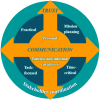Ambulance professionals' adaptations in prehospital services: a critical incident study
- PMID: 40817247
- PMCID: PMC12357368
- DOI: 10.1186/s12873-025-01309-6
Ambulance professionals' adaptations in prehospital services: a critical incident study
Abstract
Background: The working environment for ambulance professionals in prehospital services is complex, dynamic, and associated with a high degree of unpredictability. It is therefore essential that ambulance professionals adapt to provide high-quality and safe care, yet the research literature on how they successfully adapt in their everyday work remains sparse. The aim of this study is to address this knowledge gap by exploring adaptations in the context of prehospital services, through ambulance professionals' descriptions of successful missions.
Methods: A qualitative descriptive study was conducted using the Critical Incident Technique methodology for data collection and analysis, the latter through the processes of re-storying and cross-incident analysis. Twenty semi-structured individual interviews were conducted between October 2023 and May 2024 with ambulance professionals, including licensed ambulance medical technicians and paramedics with dual licensing or other additional medical licenses across four ambulance stations in Norway with contrasting geographical locations.
Results: A wide range of successful adaptations were described by the ambulance professionals and grouped into seven core themes: (1) Adaptations in mission planning; (2) Practical adaptations; (3) Time-critical adaptations; (4) Personal adaptations; (5) Task-focused adaptations; (6) Adaptations in stakeholder coordination; (7) Adapting to patients and informal caregivers.
Conclusions: This study provides insight and new knowledge about successful adaptations in prehospital services and illuminates the variety of adaptations ambulance professionals make in different contexts. Trust is an underlying feature for successful adaptations, while communication is the overall predominant feature, especially vital in stakeholder coordination and decision-making processes impacting team efforts and mission efficiency. Further research should provide insight into cross-occupational and cross-stakeholder collaborative processes.
Keywords: Adaptations; Ambulance professionals; Communication; Prehospital services.
© 2025. The Author(s).
Conflict of interest statement
Declarations. Ethics approval and consent to participate: All participants gave written informed consent to participate in the study. The study was conducted in adherence to the ethical principles of the Declaration of Helsinki. All participants were assured their anonymity and confidentiality of information. No sensitive person data was collected. This study was assessed by the National Research Ethics Committees for Medical and Health Research Ethics (No. 404260) and approved by the Norwegian Agency for Shared Services in Educations and Research (No. 792044) and the regional data protection officers of the two hospital trusts involved in the study (names and reference numbers not stated due to de-identification reasons). Clinical trial number: not applicable. Consent for publication: Not applicable. Competing interests: The authors declare no competing interests.
Figures
Similar articles
-
Community First Responders' role in the current and future rural health and care workforce: a mixed-methods study.Health Soc Care Deliv Res. 2024 Jul;12(18):1-101. doi: 10.3310/JYRT8674. Health Soc Care Deliv Res. 2024. PMID: 39054745
-
Health professionals' experience of teamwork education in acute hospital settings: a systematic review of qualitative literature.JBI Database System Rev Implement Rep. 2016 Apr;14(4):96-137. doi: 10.11124/JBISRIR-2016-1843. JBI Database System Rev Implement Rep. 2016. PMID: 27532314
-
Prescription of Controlled Substances: Benefits and Risks.2025 Jul 6. In: StatPearls [Internet]. Treasure Island (FL): StatPearls Publishing; 2025 Jan–. 2025 Jul 6. In: StatPearls [Internet]. Treasure Island (FL): StatPearls Publishing; 2025 Jan–. PMID: 30726003 Free Books & Documents.
-
Emergency Medical Services Streaming Enabled Evaluation In Trauma: The SEE-IT Feasibility RCT.Health Soc Care Deliv Res. 2025 May;13(26):1-38. doi: 10.3310/EUFS2314. Health Soc Care Deliv Res. 2025. PMID: 40445854 Clinical Trial.
-
How lived experiences of illness trajectories, burdens of treatment, and social inequalities shape service user and caregiver participation in health and social care: a theory-informed qualitative evidence synthesis.Health Soc Care Deliv Res. 2025 Jun;13(24):1-120. doi: 10.3310/HGTQ8159. Health Soc Care Deliv Res. 2025. PMID: 40548558
References
-
- Axelsson C, Herrera MJ, Bång A. How the context of ambulance care influences learning to become a specialist ambulance nurse: a Swedish perspective. Nurse Educ Today. 2016;37:8–14. Available at: https://www.sciencedirect.com/science/article/pii/S0260691715004578 - PubMed
-
- Hesselink G, Berben S, Beune T, Schoonhoven L. Improving the governance of patient safety in emergency care: a systematic review of interventions. BMJ open. 2016;6(1):e009837. Available at: http://www.proquest.com/docview/1762025644?pq-origsite=primo - PMC - PubMed
-
- Jeppesen E, Wiig S. Resilience in a prehospital setting - a new focus for future research? Scand J Trauma Resusc Emerg Med. 2020;28:104. Available at: https://www.ncbi.nlm.nih.gov/pmc/articles/PMC7579966/ - PMC - PubMed
MeSH terms
LinkOut - more resources
Full Text Sources
Medical
Miscellaneous


